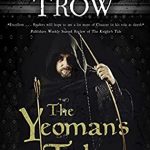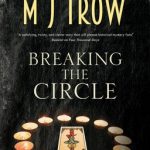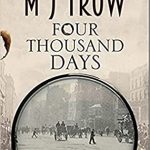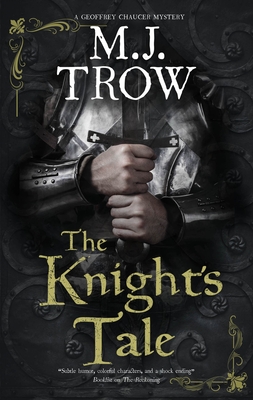 The Knight's Tale (A Geoffrey Chaucer Mystery #1) by M.J. Trow
The Knight's Tale (A Geoffrey Chaucer Mystery #1) by M.J. Trow Format: eARC
Source: supplied by publisher via NetGalley
Formats available: hardcover, ebook
Genres: historical fiction, historical mystery, mystery
Series: Geoffrey Chaucer #1
Pages: 224
Published by Severn House on August 3, 2021
Purchasing Info: Author's Website, Publisher's Website, Amazon, Barnes & Noble, Kobo, Bookshop.org
Goodreads
Introducing 14th century poet Geoffrey Chaucer as a memorable new amateur sleuth in the first of an ingeniously-conceived medieval mystery series.
April, 1380. About to set off on his annual pilgrimage, Comptroller of the King’s Woollens and court poet Geoffrey Chaucer is forced to abandon his plans following an appeal for help from an old friend. The Duke of Clarence, Chaucer’s former guardian, has been found dead in his bed at his Suffolk castle, his bedroom door locked and bolted from the inside. The man who found him, Sir Richard Glanville, suspects foul play and has asked Chaucer to investigate.
On arrival at Clare Castle, Chaucer finds his childhood home rife with bitter rivalries, ill-advised love affairs and dangerous secrets. As he questions the castle’s inhabitants, it becomes clear that more than one member of the Duke’s household had reason to wish him ill. But who among them is a cold-hearted killer? It’s up to Chaucer, with his sharp wits and eye for detail, to root out the evil within.
My Review:
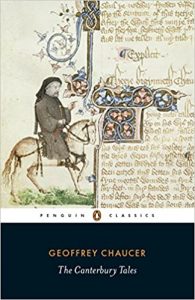 The Knight’s Tale is the first tale of Geoffrey’s Chaucer’s masterpiece, The Canterbury Tales, so it’s fitting that in this historical mystery, Chaucer himself is dragged away from his annual pilgrimage to Canterbury – his inspiration for the Tales – in order to involve himself in a Knight’s Tale of his very own, the first in a projected series that features Chaucer as the amateur “detective” investigating a mysterious death that might be murder.
The Knight’s Tale is the first tale of Geoffrey’s Chaucer’s masterpiece, The Canterbury Tales, so it’s fitting that in this historical mystery, Chaucer himself is dragged away from his annual pilgrimage to Canterbury – his inspiration for the Tales – in order to involve himself in a Knight’s Tale of his very own, the first in a projected series that features Chaucer as the amateur “detective” investigating a mysterious death that might be murder.
As the story opens, Chaucer, just hitting 40 and feeling it hit back in more ways than one, finds himself headed to Castle Clare, where he was fostered, instead of on his annual pilgrimage as he had planned. His mentor, rescuer and earliest benefactor, Lionel of Antwerp, the Duke of Clarence, has died under mysterious circumstances. Chaucer’s old friend Sir Richard Glanville has come to fetch Chaucer from London in the hopes that the man will either allay his suspicions of murder or put some meat on their bones.
There are plenty of reasons to suspect foul play, and the late Duke had made more than enough enemies for anyone to wonder if he was sent to his reward a bit earlier than heaven or hell intended. As the oldest surviving son of the late King Edward III, there are also possible political connections and motives in every direction.
But the man died alone, in bed, in a locked room on an upper floor of the castle. No one could have snuck either in or out and left the key on the inside of the lock. It’s a puzzle that Glanville hopes Chaucer can solve – as he has solved other puzzling conundrums before, whether or not murder was involved.
In a world where 21st century forensics – or even the late 19th century forensic science of Sherlock Holmes – will not be invented for centuries, it’s up to Chaucer to use his brains and his gifts for drawing people out and observing their behavior afterwards to figure out first, if there was a crime and second, if so, who committed it.
All while being distracted by his memories of the place he once called home and the love he left behind there.
Escape Rating A-: After yesterday’s book, I found myself searching for something with a straightforward plot. Not that there aren’t plenty of twists and turns and red herrings in mystery, but the genre has features that a reader can always depend on. There’s a body, a detective (however amateur), and a perpetrator with means and motive to uncover. Mystery is, after all, the romance of justice served.
This story also takes place in a period that I’ve always loved, the Plantagenet era in England, so it had the feel of the familiar. Something that still held true even though the author played seriously fast and loose with time and place. But even when I became aware of the historical inconsistencies (that Lionel of Clarence died in Italy in 1368 not England in 1380), is just the tip of that iceberg), the setting and the characters still felt more than correct enough for the whole thing to carry me along as much as I’d hoped it would.
At the same time, it also reminded me very much of two historical mystery series that are set in the same time period and that include Geoffrey Chaucer not as the protagonist but as a secondary character. The Crispin Guest Medieval Noir series (start with Veil of Lies) by Jeri Westerson and the Owen Archer series (start with The Apothecary Rose) by Candace Robb also touch on the politics and court intrigues of the Plantagenet kings and their far flung families, friends, retainers and enemies. Meaning that if you like one of the three series you’ll probably like the others.
Like the other two series I mentioned, this first book in the Geoffrey Chaucer series does an excellent job of putting the reader into the period while managing successfully not to put the reader off by making the historic characters into grand historical personages, even though they were.
Because that’s a view we have looking back. In their own time and place, they were just people, and the story does a great job of humanizing them and making them feel, well, real. It’s not just Chaucer’s brain that’s on display here, but also his nostalgia for his youth and his mourning for its loss, as well as his occasional vain attempts to be the young man he once was. He’s human and funny and sad and sarcastic and occasionally even snarktastic by turns. It makes him a fascinating amateur detective.
One I hope to see more of in future books in this series. After all, The Knight’s Tale was the first of Chaucer’s 24 published Canterbury Tales, so I have high hopes for 23 more books in this series!









